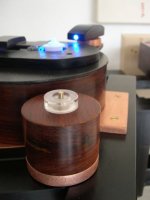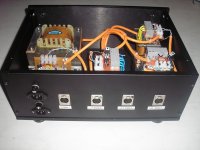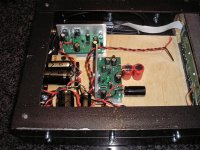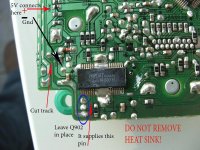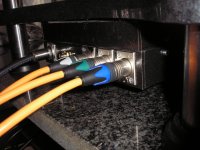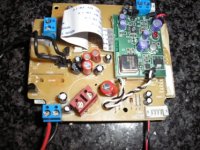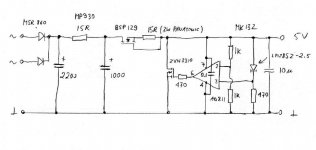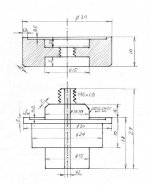Hi Peter
Those are Nichicon muse FX, but they stop production too now
The FX caps replace by FW Caps
When you mods ML38, Carlos FM used it in his ML 38
(he use 2200uf 50v for replace BG Std 1000uf 50v)
best regards
Those are Nichicon muse FX, but they stop production too now
The FX caps replace by FW Caps
When you mods ML38, Carlos FM used it in his ML 38
(he use 2200uf 50v for replace BG Std 1000uf 50v)
best regards
Those are not bipolar as they have polarity clearly indicated. I'm not sure what type it is; it only says MUSE on a jacket.
Fran encouraged me to keep the pics going so.....
Today I made a Puck-Rest.
Sometimes I seem to loose it on the floor and besides this it enables me to switch between Ebony (Fran the Man ) and Acryl.
) and Acryl.
For those interested how it is build:
Transport der Transporten
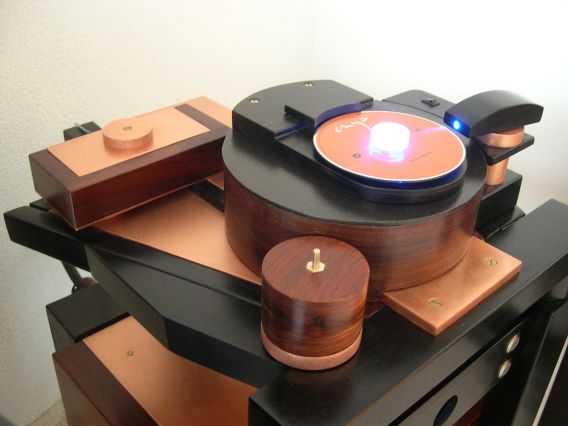
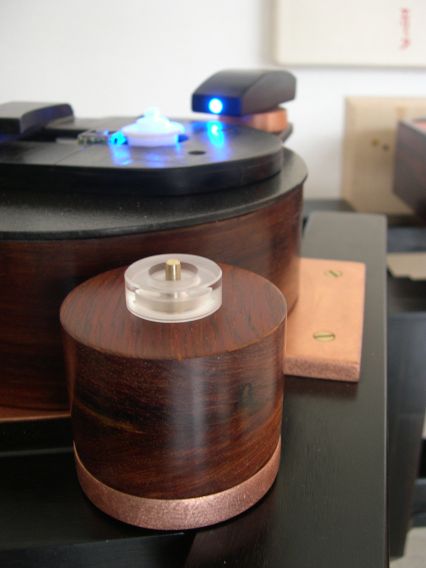
Today I made a Puck-Rest.
Sometimes I seem to loose it on the floor and besides this it enables me to switch between Ebony (Fran the Man
For those interested how it is build:
Transport der Transporten
Hi I have been testing bouth Nichicon muse and Black Gates , I cant tell the differents if someone takes a blind test on me i will not be able too tell what is what 
BUt i got a question ... have anyone teste the ebay dsix card DSIX SPDIF Digital Signal Isolation Exciter for DAC on eBay (end time 27-Jan-11 18:57:53 GMT) ?
BUt i got a question ... have anyone teste the ebay dsix card DSIX SPDIF Digital Signal Isolation Exciter for DAC on eBay (end time 27-Jan-11 18:57:53 GMT) ?
ALWSR +5 volt power supply.
What strikes me is that there are no more than a few people that have tried a separate ALWSR +5 volt power supply.
And a separate power supply plus ALWSR Regulator for the Trichord clock 4
Everything about the sound quality is told here in this thread.
Rudy
What strikes me is that there are no more than a few people that have tried a separate ALWSR +5 volt power supply.
And a separate power supply plus ALWSR Regulator for the Trichord clock 4
Everything about the sound quality is told here in this thread.
Rudy
Attachments
I was actually meaning to post the results of my capacitor tests, but somehow never got round to it... hope they will be useful to someone:Hi I have been testing bouth Nichicon muse and Black Gates , I cant tell the differents if someone takes a blind test on me i will not be able too tell what is what
PS Capacitors
Black Gate STD 1000/50 plays with crisp and clear sound, it seems to add something of a "loudness" effect, putting emphasis on the treble and also highlighting the mid-bass slightly; two of them in a PS will result in a sound that's bright, with slightly boomy bass.
BG FK 2200/35 plays in a mellower "analogue-like" manner, but if you put two of them in the PS, the effect will be a sound that is a bit dull.
I can se why Peter likes the combination of the two - the FK takes the edge off the STD, and STD gives some spark to the slightly boring FK sound. It is a very natural sounding combination, and pleasant to listen to.
I also did some experimenting with BG N 100/50 (simply because I have quite a few at hand). 100uF before and 100uF after the regulator was causing problems with spin-up, but connecting 100+100uF in super e-cap configuration before and after the voltage regulator worked practically fine, played with wonderful midrange (in fact, probably the best midrange I've heard in my system), in a typical BGN mellow/laid back manner, wonderfully natural and detailed. Unfortunately, bass was relatively too quiet (it still sounded very natural though and it took me a while to notice that something was actually missing).
Combining BGN 100/50 with the BG STD 1000/50 was a good move and that's what I was using for a while, but some bass was still missing, so I reverted to the conventional (i.e. recommended by Peter) capacitor combination and I’m very happy with them.
C916
Lots of room for experimenting here, so I tried quite many different caps; listed in the order of preference (starting with the worst):
Black Gate STD 33uF/16V
Definite improvement over the stock cap, but when compared to the N caps, they are muddy, narrow and uninteresting.
Black Gate STD 47uF/16V
Almost the same as above, and I wouldn’t be able to easily tell them apart, although I think 47uF may have been just a little bit better.
Black Gate FK 47uF/16V
Without a doubt better than the STD-series – clearer and more spacious, with good tonality. Not that much worse than the BGN 100/50, actually.
Black Gate N 100uF/50V
A bit muddier than the smaller BGNs, and seems to roll-off trebles a bit, but still gives rich midrange and is certainly not a bad choice.
Black Gate N 10uF/50V
Clearer than the 100uF, but has certain slightly shouty character, and somewhat thin bass.
Black Gate N 10uF+10uF/50V (Super E-Caps)
Improves clarity over a single 10uF, but is still not entirely neutral.
Black Gate N 33uF/16V
Balanced, rich, natural. I couldn’t really fault it. That is, until I tried…
Black Gate N 47uF/50V*)
…because in comparison 33/16 sounds a bit dry and is certainly thinner in bass. This is the cap I’m currently using.
C906
This capacitor (the original C906) should be labelled: “Here be Shigaclone magic”. It is insanely difficult to find anything that could even come close to it.
I first tried substituting it with a 0.1uF Black Gate NX Hi-Q (as we all know, possibly be the best electrolytic capacitor ever made), and while I liked its natural, relaxed tonality, there was no question that it had less of the original C906 “magic”- this ability to tell you who’s playing where and capture those minute reverberations and “live performance” feel.
I also tried a few film capacitors in 0.01uF value, as suggested by some in the original (Polish) Shigaclone thread - none of them worked well though. Even Vishay MKP-1837, a decent film cap by any standards, fell a long way short of the original C906 electrolytic, giving a flat, un-engaging sonic presentation.
The only cap that came close, and even surpassed the original in some ways was a 0.01uF/400V Multicap RTX. It actually gave slightly more resolution, although the presentation was a bit “in your face”, and it didn’t sound all that natural to me either, so I reverted to the original C906, and that’s what I’m still using.
An externally hosted image should be here but it was not working when we last tested it.
Final Notes
Please keep in mind that these are my personal observations and your mileage may vary.
I also did some comparisons of different diodes and transformers, will post them too if anyone's interested. I still have the sockets installed for diodes, both PS caps, voltage reg., C906 and C916, so if anyone has any suggestions I will be happy to try them. Anyone living in Lancashire could pop in and have a listen for him(or her)self, it's always good to get a different opinion.
*)To answer the inevitable “Where did you get all them Black Gates from?”:
I got most of them from SonicCraft last year – sadly, they don’t stock them anymore. Then I got a few from eBay as they still come up for sale occasionally. One cap was kindly sold to my by Peter (although he is running out of stocks himself). Finally, there are some BG N and STD on eBay from a Hong Kong seller; the prices are extremely steep (many times over their original price), but if it’s just a few capacitors, it may be worth it. I certainly didn’t regret spending £25 on the BGN 47/50 – but I only bought it after trying it first (as there was one included in the DAC kit I bought from Peter).
Last edited:
Hi I have been testing bouth Nichicon muse and Black Gates , I cant tell the differents if someone takes a blind test on me i will not be able too tell what is what
BUt i got a question ... have anyone teste the ebay dsix card DSIX SPDIF Digital Signal Isolation Exciter for DAC on eBay (end time 27-Jan-11 18:57:53 GMT) ?
i ordered a DSIX from the ebay seller and installed in my shigaclone. One buyer has left feedback that the board doesn't work. And i thought it may be just an isolated case. It did not work for me too. There is no spdif output. I emailed the seller and he acknowledged that there are some problem with the boards that he is offering. i believed that he must have his reasons for continuing to sell the boards while knowing that they do not work. He offered refund and graciously offered to send me a re-designed new board that will work, free of charge. I sent the board back to seller, got my refund and never hear from him again.
Thanks Peter, good to hear your observations were the sameAnd this is exactly how I feel about those caps.
Now, if you want to bring your NOS DAC to the next level, contact me through email
Here is some other stuff I was testing:
An externally hosted image should be here but it was not working when we last tested it.
Diodes:
ON Semi MUR860
Not really bad, although introduces colourations, especially in upper bass (boominess). I tried two different varieties with very similar results (although my impression was that black encapsulated was a touch better).
ON Semi MBR10100G
Better detail and treble than the MUR860, but similar colourations are present (although to a lesser extent). It could be worth trying it in an analogue circuit.
ON Semi MSR860 (black encapsulated)
Slightly better detail than the MBR10100G, but more importantly, correct and natural tonality. A good diode.
An externally hosted image should be here but it was not working when we last tested it.
ON Semi MBR16100G
Tried this one at the end and was pleasantly surprised – it sounds very similar to MSR860. It has a touch more detail and a bit more dynamic sound (to be honest, it sounds louder somehow), while MSR860 is slightly relaxed and natural in comparison. But the differences are very small and I swapped them many times to make sure I’m hearing correctly.
This is the diode I’m currently using, but I could swap to MSR860 anytime and I would be happy with it too.
An externally hosted image should be here but it was not working when we last tested it.
Transformer:
Not much testing here, I simply compared the stock boombox trafo with a custom-made high quality toroid (300VA 12-0-12, secondaries wound with 50% oversized wire, Grain-Oriented Steel core, external shielding, inter-winding shield).
The difference was in favour of the toroid, although the effect was nowhere near as pronounced as a similar change in a Gainclone (and considering how much of an overkill this trafo is, I'm wondering if it was actually worth the investment...).
Anyway, I can hear some improvement in the treble, and the sound appears to be slightly more three-dimensional, and the dynamic range is a bit better. So I'm keeping the toroid in, but honestly, the difference between it (an oversized and expensive unit), and the stock trafo was very small. One definite improvement from using the toroid is that, when playing via the built-in DAC, the background hum/noise is quieter.
An externally hosted image should be here but it was not working when we last tested it.
My conclusion - if you are looking to improve your Shigaclone, experiment with trafos only after you've ran out of other things to tinker with...
Voltage Regulators
I bought and tested 6 different types of LM7808. Unfortunately, I forgot to mark where each one came from, making the test pretty much useless for everyone else

Anyway, the differences were rather small (it is the same voltage regulator model after all), with two regs being slightly better than others (slightly better dynamics/soundstage), and two being quite clearly worse than the rest (reduced resolution and dynamics). Make did not seem to have much relevance as both the worst one and the best one were made by ST.
I have to repeat though - it honestly did not make this much difference, so don't bother yourself too much over it - unless you are determined to squeeze every last bit out of your Shiga
I'm quite sure the one I preferred is one is either this or this. Here is a picture of it:
An externally hosted image should be here but it was not working when we last tested it.
And finally a short list in order of how important/influential I found each component to be (relative, most important first):
- C906 [critical]
- C916 [very important]
- PS caps [very important]
- Diodes [influential]
- Transformer [minor influence]
- Voltage Regulator [minor influence]
I can't comment on other factors (such as case material, cables etc.) as I simply haven't tested them myself yet.
If anyone has any suggestions as to what else to test, please let me know. If it's something cheap and available in UK, I'll get it myself - if not, maybe someone will kindly make a sample accessible to me
IMHO i think you need to rerun this regulator experiment with the regs soldered in place. They dont work properly without the input output caps close to the legs. Im not quite sure how a diode can be louder! 
300VA seems total overkill for something that pulls less than 200mA.
Thats just my opinion.
But thanks for sharing the info Leon.
300VA seems total overkill for something that pulls less than 200mA.
Thats just my opinion.
But thanks for sharing the info Leon.
Last edited:
Thanks hotiron. I agree that the socketed setup is less that optimal, but every regulator had the same conditions, so I think the test was still fair. And sockets are infinitely more convenient for testing 
I'm not saying that diode was actually louder (well I don't know, I didn't measure it ), all I meant was it gave an impression of being louder: A bit more detail was audible, and instrument "attack" was more pronounced - just like it happens when you turn up the volume a bit. Anyway, the difference was small and not that important.
), all I meant was it gave an impression of being louder: A bit more detail was audible, and instrument "attack" was more pronounced - just like it happens when you turn up the volume a bit. Anyway, the difference was small and not that important.
I agree about 300VA trafo being an absolute overkill, but my previous experiments with Gainclone showed that bigger (oversized) trafo is clearly better, so I thought the same would be true for a digital circuit. In the end, it didn't make this much difference, and if I were to make another Shiga, I would settle for some 120VA (still well oversized, but hey bigger is better ).
).
I'm not saying that diode was actually louder (well I don't know, I didn't measure it
I agree about 300VA trafo being an absolute overkill, but my previous experiments with Gainclone showed that bigger (oversized) trafo is clearly better, so I thought the same would be true for a digital circuit. In the end, it didn't make this much difference, and if I were to make another Shiga, I would settle for some 120VA (still well oversized, but hey bigger is better
CD Platform with Puck for the Shigaclone
CD Platform with Puck for the Shigaclone.
Have just joined the company and have had a good conversation.
I put the price here on the forum so that there are multiple people that can benefit from this item.
The cost for a aluminium CD Platform with puck is 150 euro’s including polishing and anodizing (you can chose the color) excl. Shipping.
He found this a fun project and has a new machine where he can make this aluminium CD Platform with puck.
Please note, if I pass the order next week, I expect that the amount will transferred first, in order to avoid cancellation, I hope you all can understand that.
This weekend you can respond via Email if you want to order this item.
Here you can see the company website where I order the CD Platform with Puck: www.dondorff.nl
Regards,
Rudy
CD Platform with Puck for the Shigaclone.
Have just joined the company and have had a good conversation.
I put the price here on the forum so that there are multiple people that can benefit from this item.
The cost for a aluminium CD Platform with puck is 150 euro’s including polishing and anodizing (you can chose the color) excl. Shipping.
He found this a fun project and has a new machine where he can make this aluminium CD Platform with puck.
Please note, if I pass the order next week, I expect that the amount will transferred first, in order to avoid cancellation, I hope you all can understand that.
This weekend you can respond via Email if you want to order this item.
Here you can see the company website where I order the CD Platform with Puck: www.dondorff.nl
Regards,
Rudy
Attachments
- Home
- Source & Line
- Digital Source
- Finally, an affordable CD Transport: the Shigaclone story
